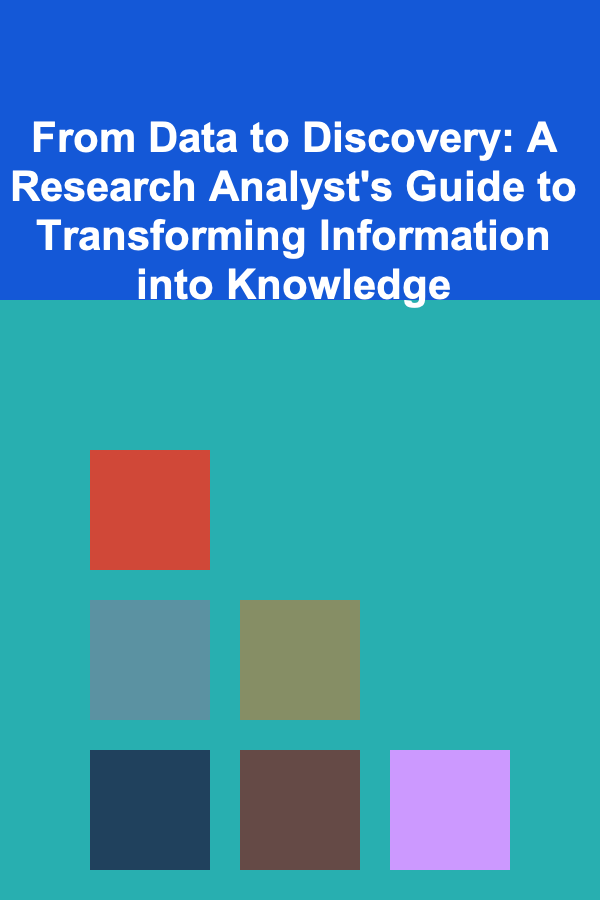
From Data to Discovery: A Research Analyst's Guide to Transforming Information into Knowledge
ebook include PDF & Audio bundle (Micro Guide)
$12.99$8.99
Limited Time Offer! Order within the next:

In today's data-driven world, organizations and individuals alike rely heavily on research analysts to convert raw data into valuable insights. These insights drive decisions, influence strategies, and fuel discoveries across industries. As a research analyst, transforming information into actionable knowledge requires more than just technical expertise in data analysis; it demands critical thinking, creativity, and the ability to communicate findings effectively. This guide will walk you through the critical steps in the research process, offering you the tools, methods, and best practices to turn data into meaningful knowledge.
Understanding the Foundation: What Is Data?
Before we dive into the process of transforming data into discovery, it's important to grasp what data is and its role in the larger research ecosystem. Data, in its rawest form, is a collection of facts, measurements, or observations that, on their own, may not offer much meaning. Data can come in various forms:
- Quantitative Data: Numerical data that can be measured and quantified. Examples include sales figures, temperature readings, or website traffic.
- Qualitative Data: Descriptive data that captures non-numeric characteristics. Examples include customer reviews, interview transcripts, or social media posts.
Data on its own doesn't inherently lead to discovery. It must be organized, analyzed, and interpreted through thoughtful methods to extract patterns, trends, and actionable insights. This process requires the tools and methodologies of a research analyst.
Defining the Research Question: The Starting Point
Every successful analysis begins with a well-defined research question. This is the guiding star of the entire process, helping to focus efforts, define data collection strategies, and select the most suitable analysis techniques.
Best Practices for Defining a Research Question:
- Be Specific: A research question should be clear and precise. Ambiguous or broad questions lead to unclear or inconclusive results. For example, instead of asking, "What are the sales trends?" try, "What factors are driving a decline in sales of product X in the last six months?"
- Align with Business or Research Goals: Ensure that the question directly ties to the broader objectives of the organization or research project. This will ensure that the insights generated are relevant and impactful.
- Consider Feasibility: Ensure that the data needed to answer the question is accessible and sufficient. A well-defined question is one that can be answered with available data and resources.
Example:
If a retail company wants to improve its customer retention rate, a well-defined research question could be: "What factors contribute most significantly to customer churn in the first 30 days after their first purchase?"
Data Collection: Gathering Raw Material
Once the research question is established, the next step is gathering the data. The quality of your data directly impacts the quality of your analysis. Therefore, careful attention to the data collection process is critical.
Types of Data Collection:
- Primary Data: Data that you collect directly from the source. This could include surveys, experiments, interviews, or observational data.
- Secondary Data: Data that has already been collected and published. This could come from public databases, company records, or industry reports.
When collecting data, always consider the relevance and quality of the data. For instance, a business may need to analyze customer behavior data through surveys and transactional data to address customer churn. Collecting data across multiple sources can give a fuller picture, provided it is aligned with the research question.
Ensuring Data Quality:
- Accurate: The data must reflect the real-world phenomena you are studying. Errors or inconsistencies at the collection stage will distort the findings.
- Complete: Missing data is common in real-world datasets. Consider how missing values will be handled before starting the analysis.
- Timely: Data should be up to date, especially if you're looking to make decisions or predictions about current or future trends.
Data Cleaning and Preprocessing: The Crucial Step
Before analysis can begin, the data must be cleaned and preprocessed. Data cleaning is the process of identifying and correcting errors or inconsistencies within the data. Preprocessing refers to transforming raw data into a format that can be effectively analyzed.
Common Data Cleaning Tasks:
- Handling Missing Data: There are several ways to deal with missing data, such as removing rows with missing values, imputing values based on the rest of the data, or flagging incomplete data for further investigation.
- Removing Duplicates: Duplicate records can skew results and lead to false conclusions. Removing duplicates ensures that each data point is unique and contributes meaningfully to the analysis.
- Correcting Outliers: Outliers are data points that differ significantly from others in the dataset. While sometimes legitimate, outliers can also result from errors. Analyzing the cause of outliers and deciding whether to remove or correct them is crucial for accurate analysis.
- Data Transformation: Sometimes, raw data needs to be transformed (e.g., normalizing numerical values, encoding categorical variables) to prepare it for analysis.
Tools for Data Cleaning:
- Excel/Google Sheets: For basic cleaning tasks like removing duplicates and handling missing values.
- Python and R: For more advanced cleaning tasks, such as handling large datasets or automating data cleaning processes.
Analyzing the Data: Turning Information into Knowledge
The core of transforming data into knowledge is the analysis phase. This is where the research analyst applies various techniques and methods to extract meaningful insights. The chosen methods depend on the nature of the data and the research question.
Common Analytical Techniques:
- Descriptive Statistics: These summarize the basic features of the data, such as mean, median, mode, and standard deviation. Descriptive statistics are useful for getting a quick overview of the data.
- Inferential Statistics: Techniques such as hypothesis testing and regression analysis fall into this category. These methods allow analysts to make generalizations or predictions based on a sample of data.
- Predictive Modeling: If the goal is to forecast future outcomes, predictive models (such as linear regression, decision trees, or machine learning algorithms) can help identify patterns and make predictions.
- Exploratory Data Analysis (EDA): EDA is an approach to analyzing datasets to summarize their main characteristics, often with visual methods. It's about finding patterns, anomalies, or relationships in the data without making specific assumptions beforehand.
How to Choose the Right Analysis Method:
- Understand the Type of Data: Quantitative vs. qualitative data requires different approaches. For instance, you would apply regression analysis to numeric data and sentiment analysis for text-based data.
- Align with the Research Question: The method should directly contribute to answering the research question. For example, if you're testing a hypothesis, you might use statistical tests like t-tests or chi-square tests.
- Validate Assumptions: Every statistical test comes with certain assumptions (e.g., normality, independence of observations). Ensure that your data meets these assumptions before proceeding with the analysis.
Data Visualization: Communicating Insights
Once the analysis is complete, the next challenge is to communicate the findings effectively. Data visualization is a powerful tool in this regard. A well-designed visualization can help stakeholders understand complex patterns and make informed decisions quickly.
Key Principles of Effective Data Visualization:
- Clarity: The visualization should be easy to understand at a glance. Avoid clutter and keep the focus on the key message.
- Accuracy: Ensure that the visual representation accurately reflects the data. Misleading graphs can lead to incorrect conclusions.
- Context: Provide context for the data. Visualizations should have appropriate labels, titles, and legends to explain what the audience is seeing.
- Actionable Insights: Highlight the key takeaways. An effective visualization not only presents data but also guides decision-makers on what actions to take based on the findings.
Tools for Data Visualization:
- Excel/Google Sheets: Basic but effective for generating bar charts, pie charts, and line graphs.
- Tableau/Power BI: Advanced tools for creating interactive and dynamic visualizations that allow users to explore data in-depth.
- Python (Matplotlib, Seaborn): For those comfortable with coding, Python offers robust libraries for custom data visualizations.
Drawing Conclusions and Making Recommendations
After completing the analysis and visualizing the findings, the final step is to interpret the results and make recommendations based on the insights derived from the data. This phase is crucial because it bridges the gap between data and actionable knowledge.
Best Practices for Drawing Conclusions:
- Be Objective: Ensure that your conclusions are based on the data and the analysis, not on personal biases or assumptions.
- Link to Business Objectives: Your conclusions should always tie back to the research question and broader organizational goals. For instance, if your analysis uncovered factors contributing to customer churn, your recommendations could focus on improving the customer experience or adjusting marketing strategies.
- Provide Actionable Recommendations: Insights are valuable only if they lead to action. Offer clear, specific recommendations that stakeholders can act on to improve outcomes.
Communicating Findings: Delivering the Knowledge
Finally, the ability to communicate your findings effectively is essential. Whether presenting to executives, researchers, or other stakeholders, clear communication ensures that the insights you uncover lead to meaningful decisions.
Tips for Effective Communication:
- Tailor the Message: Different audiences require different levels of detail. For non-technical stakeholders, focus on high-level insights, while for technical audiences, include more granular data and methodologies.
- Use Visuals: Incorporate charts, graphs, and infographics to make your findings more accessible and engaging.
- Tell a Story: Frame your findings within a narrative. Explain the problem, how you approached the analysis, the key findings, and the implications for decision-making.
Conclusion: From Data to Discovery
Transforming data into knowledge is both an art and a science. By applying the right techniques, methodologies, and tools, research analysts can uncover patterns and insights that drive meaningful decisions and discoveries. This guide has provided a roadmap for the entire research process---from defining the research question to communicating findings. With a systematic approach, a research analyst can ensure that data doesn't just remain as raw information, but is transformed into valuable knowledge that drives action and impact.

Affordable Holiday Planning: How to Save Money on Your Next Getaway
Read More
How To Make the Most of a Language Tutor
Read More
How to Organize a Backpack for Maximum Efficiency
Read More
How to Stage a Home to Make It Feel Cozy and Inviting
Read More
The B2B Sales Executive's Playbook: Essential Techniques for Success
Read More
The Interior Decorator's Guide: Transforming Spaces with Style and Function
Read MoreOther Products

Affordable Holiday Planning: How to Save Money on Your Next Getaway
Read More
How To Make the Most of a Language Tutor
Read More
How to Organize a Backpack for Maximum Efficiency
Read More
How to Stage a Home to Make It Feel Cozy and Inviting
Read More
The B2B Sales Executive's Playbook: Essential Techniques for Success
Read More